Knowing how to monitor and manage project resources can make or break that project.
One common technique that helps project managers handle resources efficiently is resource leveling.
In this article, you will learn:
- What resource leveling is
- When to use resource leveling
- The key benefits of resource leveling
- Real-world examples of resource leveling
- The risks of resource leveling
- Key resource leveling strategies
- And more!
What is resource leveling?
Resource leveling is a project management technique that adjusts project start and finish dates based on resource constraints to balance resource demand with available supply.
Project teams use resource leveling to adjust project timelines, address resource constraints, and avoid overloading.
The main goal of resource leveling is to keep workloads balanced so no team member has too much or too little work.
When to use resource leveling?
Resource leveling can help with many project scenarios. We’ll discuss some of the most important ones below.
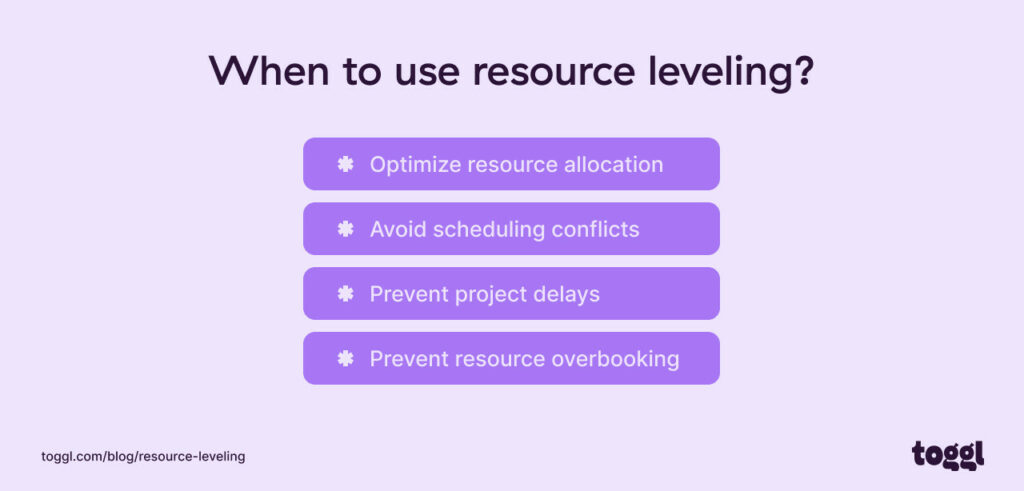
Optimizing resource allocation
If project tasks are diverse and need different skill levels, it’s essential to have a system to manage them. This system helps give people the right amount of work and avoids overwhelming them.
Using resource leveling, you create a balanced environment where everyone’s workload is manageable and matches their skill sets. You do this by following a resource-limited scheduling approach.
This balance means your team will likely complete tasks on time and have good morale and productivity.
Resource allocation becomes easier and more efficient with a resource management tool like Toggl Plan.
The Team Timeline View feature within Toggl Plan gives you a quick overview of your team’s schedule, including scheduled tasks and time off. This makes it simple to visualize schedules and spot any issues.
You can also see a team member’s workload to understand if capacity is available to allocate more work.
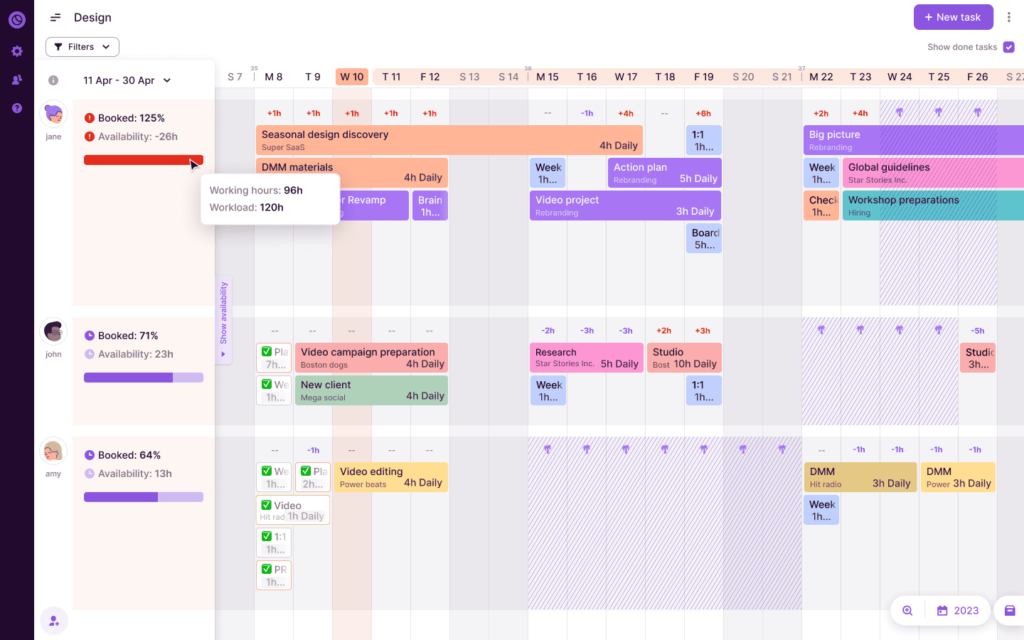
When looking at the Team timeline view, you can easily spot:
- Who’s working on what, and when
- What’s their daily, weekly, monthly, or quarterly workload
- Their availability and time off
- Their available capacity
This level of visibility lets you manage your resources with high precision.
Avoiding scheduling conflicts
Scheduling conflicts can derail even the most well-planned projects.
When team members are double-booked, delays and frustration are often the result.
Resource leveling is a proactive solution to this common issue, helping you avoid these resource conflicts before they start.
With resource leveling, you ensure each task has specific time slots to prevent overlaps in your team’s schedule.
It allows for a clear, organized view of who is doing what and when. That way, you can quickly identify potential clashes when allocating resources.
Toggl Plan can also help you avoid scheduling conflicts with its:
- Team timeline feature: The Team timeline shows each employee’s workload and availability. Knowing exactly what your team is working on allows you to assign tasks accordingly and avoid conflicts with other projects.
- Time-off feature: Toggl Plan’s Time Off feature shows whenever a task and time off overlap. If a conflict happens when you allocate tasks, you receive a conflict warning popup.
The Time Off feature also comes with pre-populated country-specific public holidays so you have one thing to worry about.
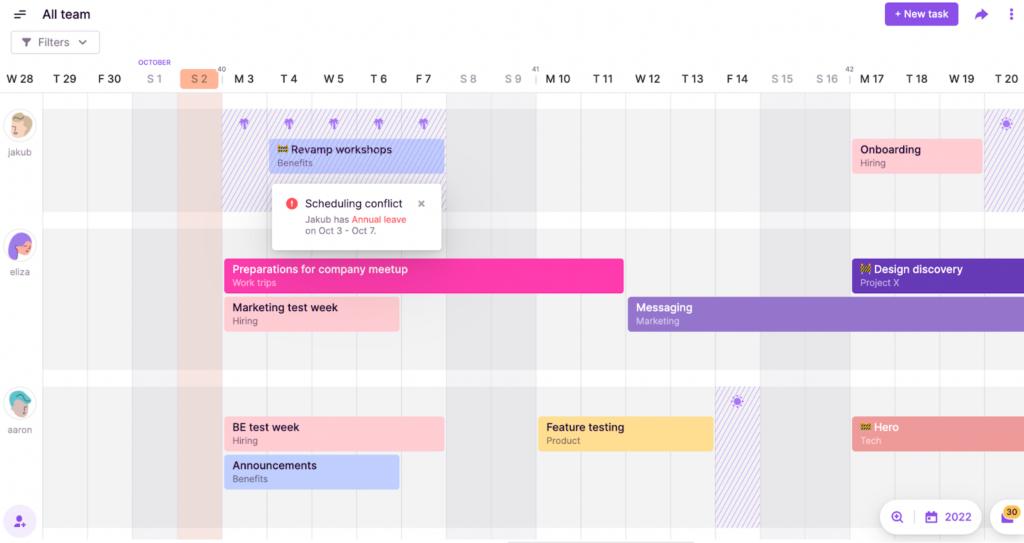
Preventing resource overbooking
Overbooking happens when you give employees more work than available work hours.
With resource leveling, you can balance workloads and allocate tasks based on resource availability to avoid overbooking.
This careful task distribution prevents burnout and boosts morale and productivity.
Toggl Plan and Toggl Track have key features that help prevent overbooking.
The Availability Overview Panel shows each team member’s available hours between two dates.

This feature lets you quickly see booking percentages, so you know how much work you can assign to your team members.
Toggl Track, which integrates seamlessly with Toggl Plan, generates insightful historical data from past projects.

With this data at your fingertips, you can create more realistic schedules and make more accurate project time estimates.
The new Analytics feature provides fully customizable charts and dashboards with time-tracking data.
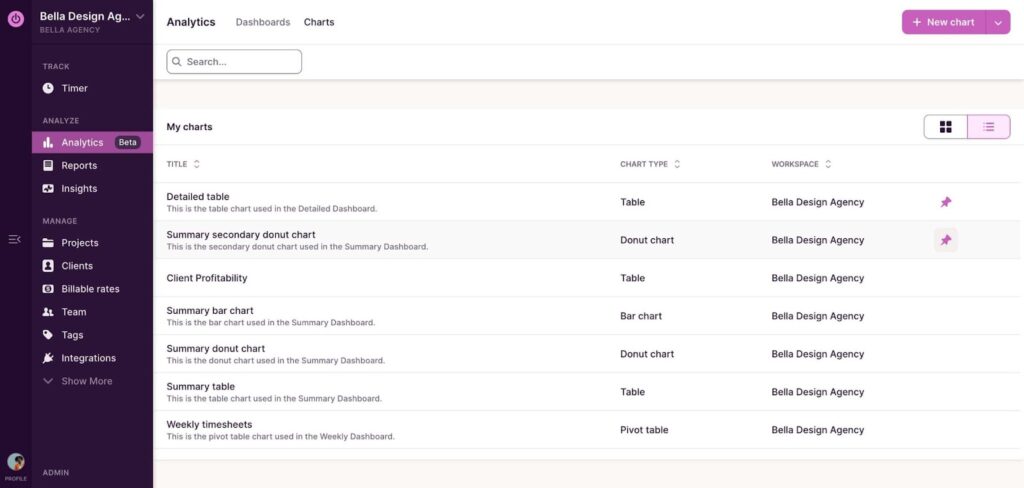
By generating these time-tracking reports, you can better understand your team’s workloads and productivity.
You have access to real-time data, which you can use to manage your resources better and prevent overbooking.
Key benefits of resource leveling
Here are the key benefits of resource leveling:
- More balanced workloads: By leveling your resources, you distribute tasks fairly and ensure every member of your team has the right amount of work.
- Improved resource allocation: With resource leveling, you maximize efficiency. You can allocate resources optimally throughout the entire project lifecycle.
- Better resource distribution: Resource leveling provides an operational flow and prevents resource bottlenecks.
- Less resource imbalances: With resource leveling, you reduce the risk of delays and cost overruns. Proactively addressing resource constraints keeps you one step ahead of project scheduling problems.
Let’s see more practical examples of how resource leveling can help you optimize human and material resources.
Examples of resource leveling
Here are some examples of resource leveling that will give you a clear idea of how to use this technique in project resource management.
Example #1: Postponing deadlines in a consulting team
Let’s say that in the middle of a project, a consulting team loses a team member because of an emergency.
Other team members with similar skills are already fully booked, and hiring a replacement at this stage seems unlikely.
So the consultancy and the client decide to postpone the project deadline so that other members with similar skills can take up the tasks of the missing team member later.
Example #2: Streamlining Project Timelines in an Agency
An agency has a new project in the pipeline but doesn’t have the people to work on it.
They’re already assigned to other projects. So the agency and client decide to move the start date where the resources are available.
That’s how you can use resource leveling in real life when you have to deal with unexpected project events.
What are the risks of resource leveling?
Although resource leveling boosts efficiency in project resource management, it’s not without risks.
Here are some potential risks of resource leveling:
- Project delays: Adjusting resources can lengthen the project timeline and delay deliverables.
- Increased complexity: Adjusting schedules and reallocating resources adds layers of complexity to the project management process.
- Budget overruns: Projects that take longer than expected can lead to additional project costs and budget overruns.
- Client dissatisfaction: Delays or project changes can fall short of client expectations and affect satisfaction.
- Team morale: Constant reshuffling can affect your team’s morale. They may feel uncertain, less motivated, and less committed to the project.
Resource leveling vs resource smoothing
Resource smoothing is a resource management technique that uses free and total float to adjust task schedules without changing the project’s critical path.
Free float refers to the amount of time you can delay a task without delaying the start of any immediately following tasks.
Total float is the amount of time you can delay a task without delaying the project deadline.
Let’s look at the main differences between resource leveling and resource smoothing.
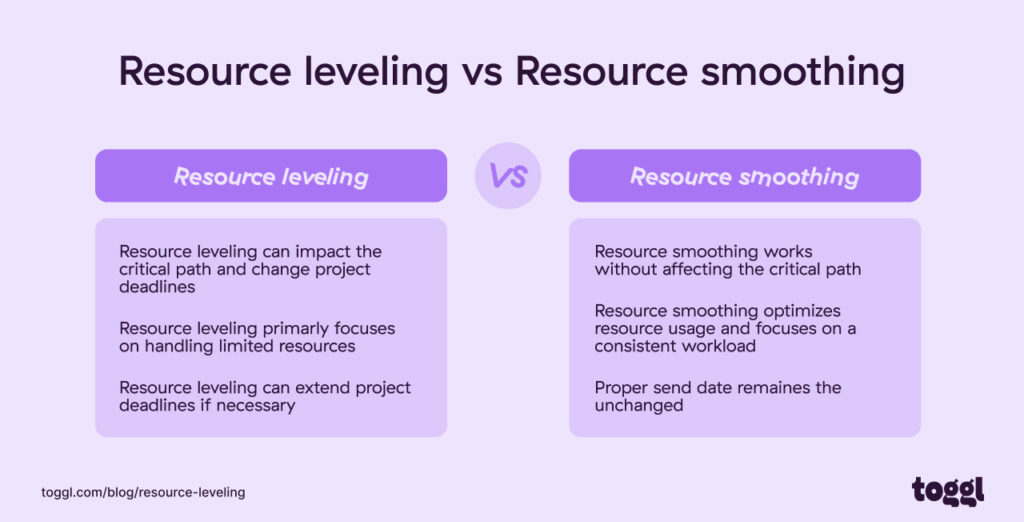
- Influence on critical path: In resource leveling, you can impact the critical path of a project and change its deadline. Resource smoothing works without affecting the critical path.
- Focus: Resource leveling primarily focuses on handling limited resources and adjusting tasks to avoid over or underused resources. Resource smoothing optimizes resource usage and focuses on a consistent workload over the project’s timeline.
- Impact on project deadline: Resource leveling can extend project deadlines if necessary, while resource smoothing ensures the project’s end date remains unchanged.
Key resource leveling strategies in project management
Successful resource leveling relies on the right strategies.
Here are the four resource leveling techniques you should know about.
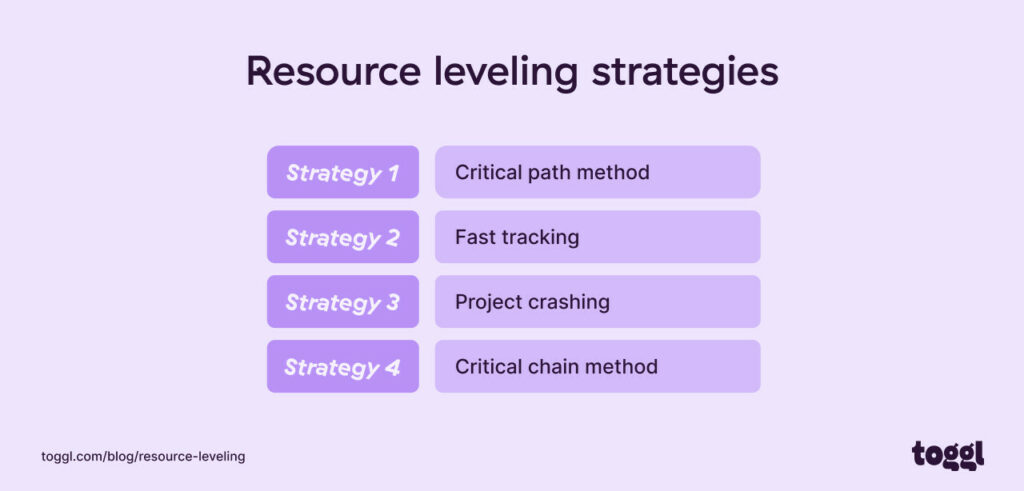
Critical path method (CPM)
The critical path method helps you identify the longest sequence of tasks that must be completed to execute a project on schedule.
The tasks in this sequence (the critical path) are crucial, as any delay in these tasks will also delay the project.
As a result, any bottleneck on this path can lead to project failure.
If you cannot solve this bottleneck by adding more resources, resource leveling is the only other option left. You can mitigate resource risks by adjusting the start and end dates of a critical path task.
Fast-tracking
Fast-tracking in project management involves executing tasks concurrently instead of performing them sequentially. As a result, this resource leveling strategy speeds up project delivery.
However, it only works when:
- The project tasks can run in parallel.
- And you have the resources to execute tasks simultaneously.
The Critical Path Method also helps you identify parallel tasks.
If you have available resources, you can apply resource leveling to adjust the start date of a task and finish the task ahead of time.
As you compress the project schedule, you have enough time and resources to dedicate to critical tasks.
Critical chain method
The critical chain method is a project planning approach that considers both tasks and resource dependencies.
Project managers use this method to include a buffer period between the project’s last task and the deadline.
By doing this, they provide a buffer time in case of delays and make sure the team finishes the project on time without becoming overwhelmed.
Resource leveling tools to know
The right tools can help you level up your resource leveling strategies.
Project management software
Project and resource planning tools like Toggl Plan have features that help visualize project resources, avoid overallocation, and prevent burnout.
With a resource and workload management tool like Toggl Plan, you can:
- Easily visualize your team’s schedule and daily workloads on Team timelines
- Plan your team’s time off and avoid scheduling conflicts
- Meet project deadlines and avoid delays
- Allocate resources more effectively throughout the project’s lifecycle
Data and estimates of past projects
Historical data from previous projects can help you plan current projects more accurately.
By analyzing this data, you can anticipate future needs and bottlenecks and make informed decisions when leveling resources.
With a time tracking tool like Toggl Track, you can:
- Accurately estimate task and project efforts using past data
- Generate reports of resource demand across all projects
Gantt charts
Gantt charts are visual tools that display project schedules with a timeline for each task.
With Gantt charts, project managers can easily see the sequence of tasks or how long tasks take and spot overlapping activities.
With this visual information, you can level and manage resources more efficiently.
You can create Gantt charts in Excel, or you can use a tool like Toggl Plan to create your Gantt chart timeline easily.
A Gantt chart timeline helps you:
- Quickly visualize project tasks and schedules
- Understand project obstacles and how to overcome them
- Avoid assigning too many or not enough tasks to team members
- Monitor and measure the progress of your projects
Now, over to you
When done right, resource leveling helps you overcome resource constraints to deliver a project successfully.
Resource management tools like Toggl Plan and simple time tracking software like Toggl Track help you nail your resource leveling efforts.
These tools help you:
- See exactly how much work your team has
- Keep projects on track and avoid delays
- Create realistic project estimates and schedules
Sign up for a free Toggl Plan account and see for yourself.
Work tools to elevate your productivity – apps for incredibly simple time tracking and effective project planning.

![What is Resource Smoothing in Project Management? [Guide]](images/resource-leveling-673x404-2.jpg)
